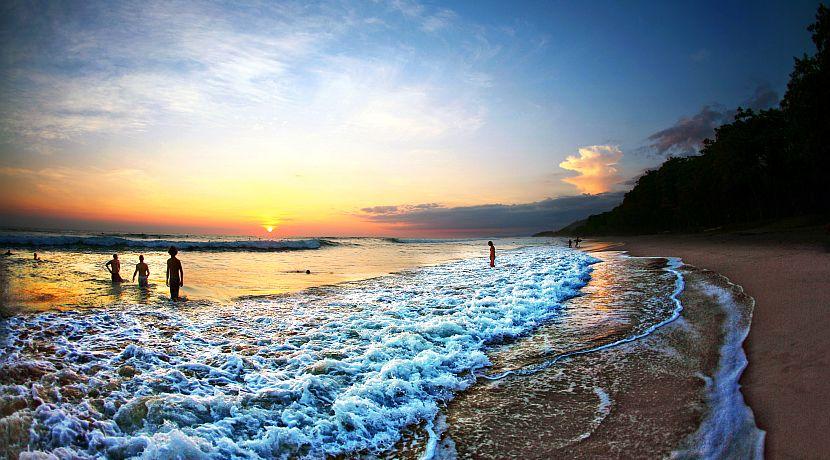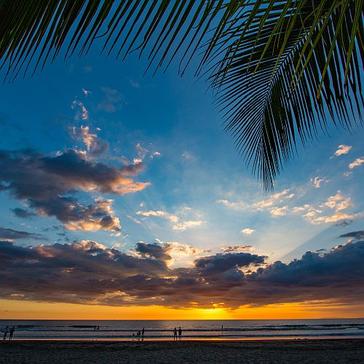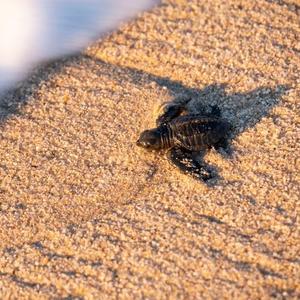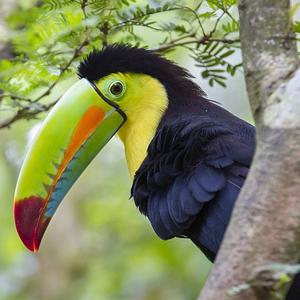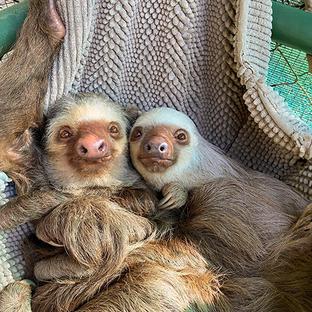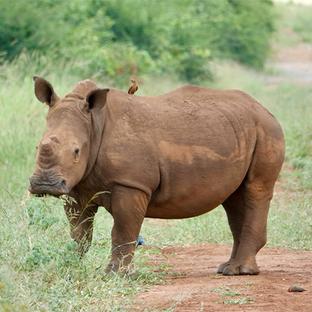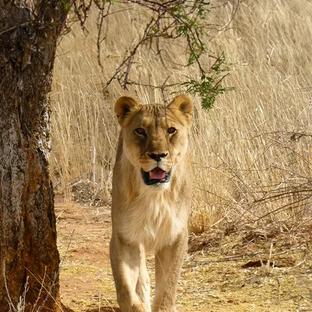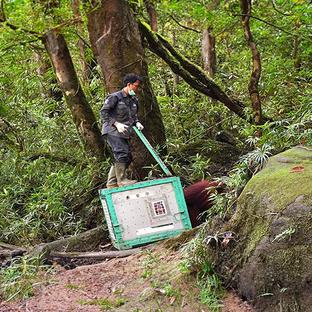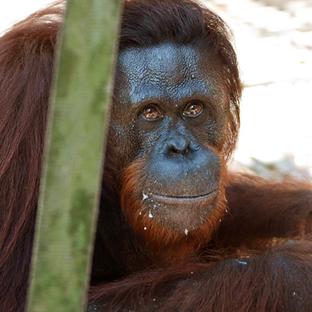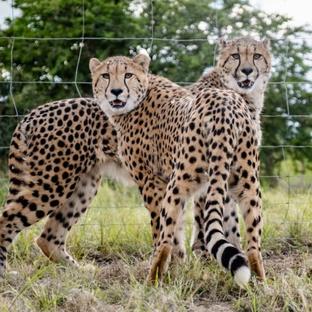Last month, we posted a blog about all the things that you can do in Cape Town, South Africa (view that A-Z by clicking here.) We’ve decided to go one bigger this time around, offering you 26 reasons why you should visit Costa Rica! Check out part one just below, before heading here to read part two.
Thinking of doing something a little different this summer? Why not consider the beautiful country of Costa Rica?
With its may waterfall paradises nestled between emerald rainforest canopies, Costa Rica is a destination concealing many secrets. Deserted beaches lay almost untouched, inviting explorers to bask in the warm, tranquil waters which lap at the shoreline. The jungles here hide all manner of exotic and exciting creatures, with the siren song of the green macaw being just as mythical as it is captivating. Adventure beckons at every turn, and Costa Rica promises to provide you with enough memories to last a lifetime. Allow us to introduce you to an A to Z of reasons why you should choose this Central American paradise as your tropical haven over the summer months.
A is for… Airports
The first thing to think about when travelling to Costa Rica is: which airport will I fly into? Costa Rica is home to a number of airports, including the two international airports (Juan Santamaria Airport in San Jose, and Daniel Oduber Airport in Liberia.) Depending on your plans during your stay in Costa Rica, San Jose’s airport is most likely to be the one that you fly into – just make such that you’re flying into the right San Jose, and not the city in California!
Assuming you do fly into San Jose (the one in Costa Rica, that is), why not consider seeing some sights while you’re there? There are a number of beautiful churches and cathedrals nearby, and since Costa Rica is quite a religious county, these holy architectures tend to be a pretty big deal. The Metropolitan Cathedral of St. Joseph, the San Isidro of Coronado Church, and Iglesia de San Jose de Orosi are all stunning in their own unique ways, ranging from the pristine white and modern, to the haunting and gothic. The latter, Iglesia de San Jose de Orosi, is actually the oldest church in all of Costa Rica: built in 1743, the building has been restored throughout the years but still holds services often. Petite, quaint and serene, Iglesia de San Jose de Orosi has to be one of the most strikingly understated churches on earth.
B is for… Beaches

Did you know that the total length of Costa Rica’s beaches spans more than that of the Dominican Republic, Fiji or the Maldives? With 1290km of coastline just waiting to be explored, Costa Rica is home to an abundance of beautiful beaches. Whether you’re into surfing (Tamarindo Beach), serenity (Conchal Beach), or wildlife-spotting (Costa Bellena – look out for the humpback whales arriving in August!), there is a beach for everybody in this lovely country. What’s more is that you don’t necessarily have to worry about renting a car to get around: Tamarindo is served by buses; you can cycle to Jaco or, again, get the bus; or if you’d like to experience a little bit of Caribbean flavour whilst on your holiday, head to Puerto Viejo de Talamanca. This tiny town has a distinct island vibe, serving up Caribbean-style grub all day long and allowing visitors to surf or spot wildlife by some of the most gorgeous beaches in the world. Of course, Puerto Viejo is easily reachable by foot, bus, bicycle or taxi.
C is for… Coffee
Costa Rica is well-known for producing a delicious cup of coffee, and anybody visiting the country really must make sure that they sample some of this country’s divine flavour.
It may come as a surprise to most of us, but did you know that Costa Rica is the only country in the world where it is actually illegal to produce any coffee other than pure Arabica? It’s true! A law was passed in 1989 prohibiting the planting of low-quality beans, ensuring that farmers across the land could only produce the finest quality. It may seem a little odd and full-on, but trust us: Costa Rican coffee is absolutely worth it and, as such, we suppose we’re all thankful for this country’s quirky law.
Further to Costa Rica’s coffee pride is the fact that every last bean is hand-picked from the plant. Cultural heritage runs deep, with generation after generation learning how to grow and select their beans as to assure that only the best flavours are associated with the country. This means so rushing of the process, and no machines to tear up the land: by hand-picking each bean, only the ripest are plucked and processed, and the land on which the coffee grows remains healthy as can be. Coffee plantations are run sustainably, meaning that the farms remain in good health – great for the planet, and yet another reason for the coffee farmers to be proud of their produce.
D is for… Diving
Thanks to its miles of crystalline coastline, Costa Rica is an ideal location for diving and snorkelling. Gandoca Manzanillo Wildlife Refuge (on the Southern Caribbean Coast) is just one of many locations in which you can witness an abundance of alluring marine life: coral reefs, bays, inlets, and islands each attract animals such as sea turtles, manatees, and dolphins!
Elsewhere, the Cahuita National Park (also on the Southern Caribbean Coast) boasts one of the largest living coral reefs on earth, with over 35 species of coral to be found in the waters here. Either stroll across a 5.6 trail along the shoreline, or get into the water at Punta Cahuita, one of the best snorkelling spots in the park. Things get especially fun here around October time, when the colourful reggae-infused Carnival festival is in full swing.
E is for… Eco-Tourism
Costa Rica is incredibly conscious of its duty to protect all things natural, and as such there has been a boom in the amount of eco-tourism opportunities available. The Great Projects are proud to offer the opportunity to take part in sea turtle conservation at Reserva Playa Tortuga, located within the Terraba-Sierpe basin. Here, volunteers can work with local communities, national and international governments, and non-governmental organisations to promote environmental awareness and conservation actions in the hopes of encouraging responsible tourism in the area. Of course, the main event of a trip like this (the Costa Rica Turtle Conservation Experience) is the ability to witness some beautiful animal species – including four species of turtle.
One of the main species of turtle that volunteers will be involved with is the Olive Ridley turtle. This is an increasingly rare member of the turtle family, and needs our protection more than ever before. Volunteers will be able to collect data on these animals, overseeing them throughout the day and even in the evening on night patrols, and potentially even having the opportunity to bury turtle eggs or watch new ones grow. August is the perfect time to visit this project as the turtles return to nest at this time of year, allowing anybody visiting the project site to witness an incredibly moving display of nature at its finest.
Not a fan of sea turtles? No worries. Stick with us, as we’ll be announcing a brand-new project in the not-too-distant future…
F is for… Food

Food makes the world go round. That’s a fact. Or, at least it is when it comes to travel – do you really know a country until you’ve tried their signature dish? In Costa Rica, that dish is ‘Gallo Pinto’: a relatively simple meal which is well-loved by the country’s own people and tourists alike. Gallo Pinto consists of rice and beans, stir-fried together to create a speckled appearance. It is then served alongside eggs and sour cream or cheese, typically served at breakfast but available to eat in any restaurant at any time. As well as being very affordable, Gallo Pinto is also an incredibly filling dish – perfect for filling your belly when out adventuring!
Other delicacies that you have to try include: fried plantains; tres leche cake; ceviche; and the curiously named Agua de Sapo. Translating to ‘toad water’, Agua de Sapo may seem to be offputting at first…but give it a go, and you’ll soon find yourself enjoying a delicious, refreshing blend of lemonade, ginger and brown sugar. Yum!
G is for… Green Macaws
The green macaw is one of the most instantly recognisable animals in all of the Americas: its bright, eye-catching colouring cannot be missed, nor can its loud, raucous vocalisation! Sadly, the green macaw is at threat due to habitat loss and unsustainable harvest – in Costa Rica, 90% of suitable habitat has sadly been lost, and more must be done to make room for this animal.
As part of an incentive to protect the green macaw, festivals are held in an attempt to raise conservation awareness, with local farmers and nest caretakers alike receiving prizes for their contribution to the cause. In addition to these, there are protected spaces for the birds to be found in Costa Rica: The San Juan-La Selva Biological Corridor, in particular, being extremely important to the great green macaw and hundreds of other species. Here, six protected areas are connected and allow the animals to move between regions safely and with ease.
H is for… Happiness
It has been said that Costa Rica is the happiest place on earth, and with a plethora of reasons why, the country’s high ranking on happyplanetindex.org soon becomes apparent. With high levels of equality, long life expectancies, and low levels of inequality, Costa Rica is well-loved by its people. So, what works for Costa Rica?
Well, it seems that a lack of an army has helped the nation out a great deal. By abolishing their army back in 1949, Costa Rica’s government have been reallocated funds to be spent on education, health and pensions. (And when it comes to education, did you know that Costa Rica is one of the most literate countries in the world?) Another way in which the country has maintained its people’s happiness is through its ecological stance: 99% of the country’s electricity was produced from renewable sources in 2015, and the government aims for Costa Rica to be carbon-neutral by 2021.
I is for… Indigenous Communities
Costa Rica has a fascinating history, which in part can be revealed through its indigenous communities. While the indigenous groups here are not as well-documented as, say, the Incas or the Aztecs, they definitely have their place in history and still have survive today, opening a fascinating window into the beginnings of the country we know today.
The Boruca Tribe are found in southern Costa Rica, and are well known for their crafts, particularly the masks made for the ‘Fiesta de los Diablos’, a three-day festival which depicts the battle between the Boruca Indians and the Spanish conquistadors (the former portrayed as devils; the latter shown as bulls.) There are around 2,660 people in the tribe today, which is quite a considerable size compared to other groups such as the Cabecar Indians, the Guaymi, and the Maleku.
However, the largest group is perhaps the Bribri tribe: residing on the southern Atlantic coast, their populations are anywhere between 11,000 to 35,000. Fascinatingly, women are of the highest social class in this society, and are the only one who are able to inherit land and prepare the sacred cacao drink used in rituals. Despite their close links to tradition, this tribe are relatively modernised in that they are politically influential, being a voting majority in the region of Puerto Viejo de Talamanca!
J is for… Jungles

There’s a good reason why jungles have put this country on the map. Lush, verdant canopies make up much of Costa Rica’s landscape, and there is much to discover beneath the jade cloak of nature. Animals of all walks of life roam freely among the underbrush; countless avian calls can be heard for miles around; and a wealth of unusual and beautiful flora add zest and vibrancy to a mass of otherwise green plantlife.
As previously mentioned, there are numerous animals to be discovered in Costa Rica’s jungles – just be weary of wandering off on your own! The strawberry poison dart frog, the white headed capuchin monkey, the ocelot, and the three toed sloth all make their home in the jungle, but perhaps the most glorious and unusual of them all is the chestnut-mandibled toucan. This big-beaked beauty is instantly recognisable for its banana-coloured bill, and the flecks of red around its breast and near its face, with other shades of green and blue adorning its features. Whether you’ll manage to spot a toucan during your stay in Costa Rica remains to be seen, but one thing is for sure: this country’s wildlife is unlike anything else on earth.
K is for… Kayaking
For a country that is abundant in vegetation and foliage, Costa Rica’s people sure do love to spend time out on the water – and what better way to make the best of both worlds than by paddling through jungle rivers in a kayak?!
There are a multitude of kayaking opportunities to be had in Costa Rica, with many of them opting to take the scenic route across winding rivers, closeby to tangled mangroves and even potential animal sightings. Others go a little bigger, out into the great wide open of Lake Arenal with the striking view of Arenal Volcano as the backdrop. Whatever your preference, a kayak trip should absolutely make your list of things to do.
L is for… Lankester Gardens
The Lankester Botanical Gardens are recommended as one of the best places to visit in all of Costa Rica, and just a quick glance at its stunning grounds reveals the reason why. Known most of all for its orchids, the Lankester Botanical Gardens have been open to the public since 1973, but were previously owned by a man named Charles H. Lankester.
Lankester was an keen naturalist who, originally hailing from England, decided to move to Costa Rica later in life. An orchid enthusiast, Lankester curated a private garden full of the flower. After his death, the gardens were preserved and were eventually donated to the University of Costa Rica.
Today, the Lankester Garden works to promote conservation efforts in Costa Rica by encouraging tourists to enjoy the flora, and by allowing the gardens to be used for scientific research and environmental education. With some 11 hectares of land and over 3000 species of plant, the Lankester Gardens are certainly worth a visit.
M is for… Museums
There are several interesting museums to visit in Costa Rica, including the Museum of Indigenous Art, and the Museum of Criminology. One of the more unique museums, however, is the Pre-Columbian Gold Museum: often ranked amongst the top experiences of things to do in Costa Rica, the Gold museum is located in San Jose and is home to a substantial collection of artefacts dating all the way back to AD 500. In Costa Rican history, gold was considered a symbol of authority, and it is fascinating to think of the people who may have originally owned such lavish items of affluence.
Check out part two of our A-Z of Costa Rica by clicking here, or head to our destination page to see which projects you could be a part of!
